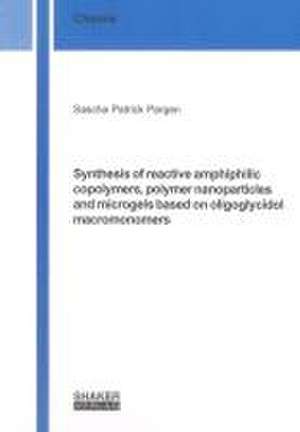Synthesis of reactive amphiphilic copolymers, polymer nanoparticles and microgels based on oligoglycidol macromonomers: Berichte aus der Chemie
Autor Sascha Patrick Pargenen Limba Engleză Paperback – 28 feb 2013
Din seria Berichte aus der Chemie
-
 Preț: 81.13 lei
Preț: 81.13 lei -
 Preț: 246.81 lei
Preț: 246.81 lei -
 Preț: 237.59 lei
Preț: 237.59 lei -
 Preț: 61.58 lei
Preț: 61.58 lei -
 Preț: 281.48 lei
Preț: 281.48 lei -
 Preț: 270.67 lei
Preț: 270.67 lei -
 Preț: 296.73 lei
Preț: 296.73 lei -
 Preț: 260.04 lei
Preț: 260.04 lei -
 Preț: 277.92 lei
Preț: 277.92 lei -
 Preț: 280.86 lei
Preț: 280.86 lei -
 Preț: 264.14 lei
Preț: 264.14 lei -
 Preț: 295.59 lei
Preț: 295.59 lei -
 Preț: 277.76 lei
Preț: 277.76 lei -
 Preț: 262.40 lei
Preț: 262.40 lei -
 Preț: 278.38 lei
Preț: 278.38 lei -
 Preț: 261.30 lei
Preț: 261.30 lei -
 Preț: 245.65 lei
Preț: 245.65 lei -
 Preț: 246.81 lei
Preț: 246.81 lei -
 Preț: 263.06 lei
Preț: 263.06 lei -
 Preț: 282.35 lei
Preț: 282.35 lei -
 Preț: 290.21 lei
Preț: 290.21 lei -
 Preț: 261.14 lei
Preț: 261.14 lei -
 Preț: 264.36 lei
Preț: 264.36 lei -
 Preț: 267.41 lei
Preț: 267.41 lei -
 Preț: 271.09 lei
Preț: 271.09 lei -
 Preț: 244.11 lei
Preț: 244.11 lei -
 Preț: 281.25 lei
Preț: 281.25 lei -
 Preț: 268.24 lei
Preț: 268.24 lei -
 Preț: 273.64 lei
Preț: 273.64 lei -
 Preț: 194.31 lei
Preț: 194.31 lei -
 Preț: 170.42 lei
Preț: 170.42 lei -
 Preț: 200.82 lei
Preț: 200.82 lei -
 Preț: 202.08 lei
Preț: 202.08 lei -
 Preț: 282.37 lei
Preț: 282.37 lei -
 Preț: 287.35 lei
Preț: 287.35 lei -
 Preț: 279.15 lei
Preț: 279.15 lei -
 Preț: 261.17 lei
Preț: 261.17 lei -
 Preț: 274.81 lei
Preț: 274.81 lei -
 Preț: 245.36 lei
Preț: 245.36 lei -
 Preț: 245.58 lei
Preț: 245.58 lei -
 Preț: 278.46 lei
Preț: 278.46 lei -
 Preț: 261.05 lei
Preț: 261.05 lei -
 Preț: 196.74 lei
Preț: 196.74 lei -
 Preț: 286.80 lei
Preț: 286.80 lei
Preț: 280.93 lei
Nou
Puncte Express: 421
Preț estimativ în valută:
53.76€ • 58.57$ • 45.30£
53.76€ • 58.57$ • 45.30£
Carte indisponibilă temporar
Doresc să fiu notificat când acest titlu va fi disponibil:
Se trimite...
Preluare comenzi: 021 569.72.76
Specificații
ISBN-13: 9783844017540
ISBN-10: 3844017542
Pagini: 170
Dimensiuni: 149 x 212 x 12 mm
Greutate: 0.26 kg
Editura: Shaker Verlag
Seria Berichte aus der Chemie
ISBN-10: 3844017542
Pagini: 170
Dimensiuni: 149 x 212 x 12 mm
Greutate: 0.26 kg
Editura: Shaker Verlag
Seria Berichte aus der Chemie
